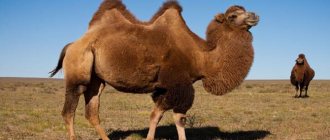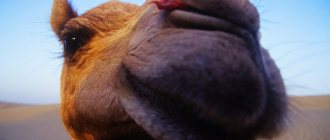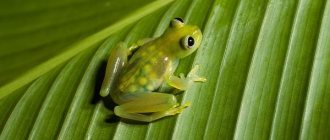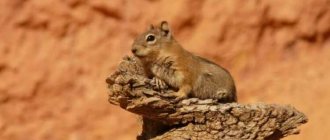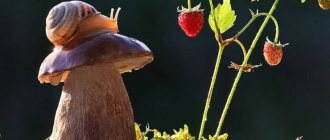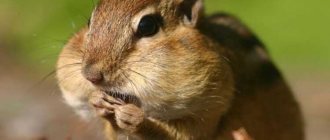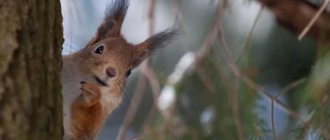- Wild animals
- >>
- Mammals
The gibbon is a slender, rather graceful and cunning primate from the gibbon family. The family includes about 16 species of primates. Each of them differs in habitat, eating habits, and appearance. This type of monkey is very interesting to watch, as they are very playful and funny animals. A distinctive feature of gibbons is considered to be sociability not only in relation to their relatives, but also in relation to representatives of other animal species and humans. It is noteworthy that primates express their readiness to communicate and friendliness by opening their mouths and raising their corners. This creates the impression of a welcoming smile.
Origin of the species and description
Photo: Gibbon
Gibbons belong to chordates; they are classified into the class Mammals, the order of primates, and the subfamily Gibbonidae. To date, the origin of gibbons is the least studied by scientists compared to the origin and evolution of other primate species.
Available fossil finds indicate that they already existed during the Pliocene period. The ancient ancestor of modern gibbons was Yuanmoupithecus, which existed in Southern China approximately 7-9 million years ago. They are united with these ancestors by their appearance and way of life. It is worth noting that the structure of the jaw has remained virtually unchanged in modern gibbons.
Video: Gibbon
There is another version of the origin of gibbons - from Pliobates. These are ancient primates that existed on the territory of modern Europe approximately 11-11.5 million years ago. Scientists have discovered fossil remains of an ancient Plyobates.
He had a very specific skeletal structure, in particular the skull. They have a very large, voluminous, somewhat compressed brain case. It is worth noting that the front part is quite small, but at the same time it has huge round eye sockets. Although the braincase is large, the brain compartment is small, indicating that the brain was small. Pliobates, like gibbons, had incredibly long limbs.
Songs of the gibbons. Why are they singing?
Among other monkeys, gibbons are famous primarily for their screams, or rather songs. Perhaps these are some of the most amazing and unusual sounds that can be heard in the tropical forests of Asia. The singing can be heard for several kilometers.
A single male singing can most often be heard before sunrise. The aria begins with a series of soft, simple trills that gradually develop into a series of more complex loud sounds. The song ends with dawn. In the fast gibbon, for example, the final part of the aria is twice as long as the first part and contains 2 times as many notes. The final cry of the Kloss gibbon is called the “quivering song.”
Females usually start singing in the late morning. Their song is shorter and less variable. They just repeat the same tune over and over again. But even despite the repetitions, it makes a lasting impression. The so-called “great song” of the female lasts from 7 to 30 seconds.
Perhaps most expressive is the song of the female Kloss gibbon, which is described as “the most beautiful sounds that a wild mammal can make.”
Although the males have a very varied repertoire, the song is always performed in a relatively low key. Females are real “drama queens” compared to males.
Gibbons also sing during the day, choosing a tall tree on which a whole performance is performed, which, among other things, includes swinging on the branches. During the “performance,” when the song reaches its climax and the crescendo of the female’s “great song” sounds, dry branches break with a crash and fall down.
Why do gibbons sing? They do this for different purposes. Firstly, in order to notify other group members of your location.
Previously, it was believed that male gibbons sing in order to protect the feeding territory of their girlfriend, but now most zoologists are inclined to believe that the main purpose of singing is to protect the girlfriend herself from the encroachments of single males.
Males sing more often, once every 2-4 days, when there are many lonely males around, and where their numbers are small, they may not sing at all. By listening to the singing, bachelors can assess the physical condition of their “married” rivals, and, consequently, their ability to protect their girlfriends.
The female's singing techniques largely depend on how eager her neighbors are to enter her territory and steal fruit. With her repertoire, she notifies food competitors of her presence and that she does not want to see them on her site. They usually start their songs every 2-3 days. If there are a lot of relatives around, females can sing every day.
In many populations, males sing with females in a complex duet that boils down to the same constituent elements: an introduction, during which males, females and young individuals “warm up”; alternating calls of the male and female (when they coordinate their parts); “great song” of the female and the final coda.
The degree of synchrony and coherence among partners increases over time, so the quality of the duet can serve as an indicator of the duration of the couple’s existence.
Some scientists believe that duets promote pair formation and help maintain bonds between partners.
It is now generally accepted that couples perform their duets in populations where territorial invasions often occur. Thus, the owners of the territory declare their exclusive rights to this very territory. By supporting the female while she sings, the male signals to neighbors about his presence in her territory, which reduces the risk of territorial skirmishes.
Appearance and features
Photo: What a gibbon looks like
The body length of one adult individual ranges from 40 to 100 centimeters. Animals exhibit sexual dimorphism. Females are smaller in size and body weight compared to males. Body weight on average ranges from 4.5 to 12.5 kilograms.
Gibbons have a slender, lean, elongated physique. Zoologists note that this species of primate has much in common with humans. They, just like humans, have 32 teeth and a similar jaw structure. They have quite long and very sharp fangs.
Interesting fact: Primates have blood types - 2, 3, 4, like humans. The difference lies in the absence of the first group.
Gibbons have a small head with a very expressive facial part. Primates have closely spaced nostrils, dark, large eyes and a wide mouth. The monkeys' bodies are covered with thick fur. There is no hair on the front of the head, palms, feet and ischium. The skin color of all representatives of this family, regardless of species, is black. Coat color differs among different subspecies of this family. It can be either monochromatic, most often dark, or have lighter areas on certain parts of the body. There are representatives of some subspecies in which, as an exception, light fur predominates.
Of particular interest are the limbs of primates. They have incredibly long forelimbs. Their length is almost twice as long as the hind limbs. In this regard, gibbons can easily rely on their forelimbs when simply standing or moving. The front paws serve as hands. The palms are very long and rather narrow. They have five fingers, and the first finger is quite far to the side.
Group Behavior
This species of primate tends to form families that live in limited areas. The average white-handed gibbon family consists of 2-7 individuals, including a female, a male and cubs of different groups. Sometimes several elderly individuals live in a gibbon family. Each such family of monkeys occupies its own territory, and clashes regularly occur between neighbors. This, as a rule, is not a fight, but only a manifestation of demonstrative threatening sounds and poses. One family can occupy an area with an area of 0.1-0.4 square meters. km.
Where does the gibbon live?
Photo: Gibbon in nature
Different representatives of this species have different habitats:
- northern regions of China;
- Vietnam;
- Laaos;
- Cambodia;
- Burma;
- Malacca Island;
- Sumatra island;
- India;
- Mentawai Island;
- western regions of the island of Java;
- Kalimantan island.
Gibbons can feel quite comfortable in almost any region. Most populations live in tropical rainforests. They can inhabit dry forests. Families of primates live in valleys, hilly or mountainous areas. There are populations that can rise to heights of up to 2000 meters above sea level.
Each primate family occupies a specific territory. The area occupied by one family can reach 200 square kilometers. Unfortunately, previously the habitat of gibbons was much wider. Today, zoologists note the annual narrowing of the distribution range of primates. A prerequisite for the normal functioning of primates is the presence of tall trees.
Now you know where the gibbon lives. Let's see what he eats.
History of evolution[edit]
Whole-genome molecular dating analysis suggests that the gibbon lineage diverged from the ape lineage around 16.8 million years ago (Ma) (95% confidence interval: 15.9–17.6 Ma; assuming a divergence of 29 Ma back with the monkeys of the Old World). [7] Adaptive divergence associated with chromosomal rearrangements led to the rapid radiation of four genera 5–7 Mya. Each genus contains a distinct, well-defined lineage, but the sequence and timing of divergences between these genera has been difficult to determine, even with complete genome data, due to radiation speciation and extensive incomplete lineage sorting. [7][8] Analysis based on morphology suggests that the four genera are ordered as ( Symphalangus
, (
Nomascus
, (
Hoolock
,
Hylobates
))). [9]
| Hominoids (hominoids, apes) | |
| Gilobates | |
| Hominins |
|
What does a gibbon eat?
Photo: Gibbon monkey
Gibbons can safely be called omnivores, as they feed on food of both plant and animal origin. They very carefully explore the territory they occupy for suitable food. Due to the fact that they live in the crowns of evergreen forests, they can provide themselves with food all year round. In such places, monkeys can find food almost all year round.
In addition to berries and ripe fruits, animals need a source of protein - food of animal origin. As food of animal origin, gibbons eat larvae, insects, beetles, etc. In some cases, they can feed on the eggs of birds that build their nests in the crowns of trees where primates live.
Adults go out in search of food approximately in the morning after their morning toilet. They don't just eat lush green vegetation or tear fruits, they carefully sort through them. If the fruit is not yet ripe, gibbons leave it on the tree, allowing it to ripen and fill with juice. The monkey plucks fruits and foliage with its forelimbs, like hands.
On average, at least 3-4 hours a day are spent searching for and eating food. Monkeys tend to carefully not only select fruits, but also chew their food. On average, one adult requires about 3-4 kilograms of food per day.
Nutrition
Gibbons have adapted to live in the treetops of evergreen tropical forests. Here, at any time of the year, you can find fruiting species of vines and trees, so primates are provided with their favorite fruits all year round. In addition to fruits, they eat large quantities of leaves, as well as invertebrates - the main source of animal protein for them.
Unlike monkeys, which usually feed in large groups and can digest even unripe fruits, gibbons choose only ripe fruits. Before picking even a small fruit, the monkey always checks its ripeness by squeezing it between his thumb and forefinger. Primates leave the unripe fruit on the tree to give it a chance to ripen.
Features of character and lifestyle
Photo: Gibbon
Gibbons are diurnal primates. At night, they mostly rest, going to bed high in the treetops with the whole family.
Interesting fact: Animals have a certain daily routine. They are able to distribute their time so that it is evenly allocated to food, rest, caring for each other's fur, caring for offspring, etc.
This type of primate can be safely classified as arboreal. They rarely move on the surface of the earth. The forelimbs make it possible to swing strongly and jump from branch to branch. The length of such jumps is up to three meters or more. Thus, the speed of movement of monkeys is 14-16 kilometers per hour.
Each family lives in a certain territory, which is jealously guarded by its members. At dawn, gibbons climb high into a tree and sing loud, shrill songs, which are a symbol that the given territory is already occupied and should not be encroached upon. After getting up, the animals clean themselves up by performing bath procedures.
In rare exceptions, single individuals can be accepted into the family, who for some reason have lost their other half, and sexually mature cubs separated and created their own families. In cases where, upon the onset of puberty, young individuals do not leave the family, the older generation drives them away by force. It is worth noting the fact that often adult parents occupy and guard additional areas where their children subsequently settle, creating families.
After the primates have had their fill, they happily go to their favorite nests to rest. There they can lie motionless for hours, basking in the sun's rays. After eating and resting, the animals begin cleaning their fur, which they spend a lot of time on.
Gibbons are not people, but they are similar - 15 photos
Gibbons (lat. Hylobates) are a genus of anthropoid primates that live in Southeast Asia. One of four genera of the gibbon family. Previously it was the only genus in this family, but recently Nomascus, Siamang and Khuloki were also included in the category of genera. Gibbons are the most diverse and widespread of the gibbon genus, found from southern China (Yunnan) to Western and Central Java. Members of this genus have 44 chromosomes and often have a ring of white fur around the face.
of monkeys in the world that have good tenacious hands and developed brains. They are distinguished from humans by the presence of a grasping and tenacious tail, body structure, lower level of intelligence, as well as the lifestyle they lead. One of the most amazing monkeys is the gibbon , which spends a significant part of its life in a tree at a height of more than ten meters. He comes to earth only to find food.
Interestingly, this monkey, having a large body weight, can cover a distance of 3.5 meters in one jump, which is almost seven times the length of a human jump. This is facilitated by the long forelimbs, which the gibbon uses like a pendulum. Before each jump, he extends his arms forward, thereby giving them additional momentum. By the way, his forelimbs are much longer than his hind limbs.
It is also curious that the gibbon can sing in a high, clear tone. According to scientists, this is the only animal that can sing, and not just make sounds. The gibbon usually sings in the morning, immediately after waking up from sleep, along with his relatives, this is how he protects his territory. His evening concerts happen less often.
Another interesting fact is that the cub of this animal is born 210 days after conception, practically naked, its weight is very small. Mom carries him on her stomach, warming him with her body, for almost two years. After another five years, the child becomes sexually mature and finds a permanent mate. He will create a family once and for the rest of his life.
Gibbon monkeys, whose interesting facts are so varied, do not like to swim and avoid water in every possible way. They eat mainly plants (more than 160 species), although they also do not refuse insects, bird eggs and small vertebrates.
Most gibbon subspecies eat only fruit.
Gibbons are tailless monkeys with glossy black hair on their bodies. They often have white markings on the face, arms and legs. Gibbons have strong, hook-shaped hands that they use for gripping, unusually large hands (for all gibbon species), larger in size than their feet. The shoulders of gibbons are folded in such a way that they allow them to move on their hands along branches over long distances. They can reach speeds of up to fifty-six kilometers per hour.
Gibbons defend their territory with daily singing rituals that begin around nine o'clock in the morning and last for about an hour. These loud songs can be heard two to three kilometers away. Gibbons eat at least one hundred and sixty types of plants, their favorite foods being fruits and rice. However, they sometimes feed on insects, bird eggs and small vertebrates.
Gibbons are monogamous, one of the few primate species that form a single pair for life. They live in families that consist of four to six individuals. A gibbon troop consists of a dominant male, a dominant female, cubs, and less dominant individuals. The latter leave the pack when they are eight years old.
The gibbon rests 50% of its waking time. As a rule, they use a tall tree for this purpose, on the branches of which they lie on their stomachs or on their backs. Gibbons have highly developed brains, like all other primates.
For adult gibbons, grooming is an important social ritual. They spend up to fifteen minutes on it every day.
Gibbon cubs are weaned after they are one year old, but they remain with their mother until they are five years old. Then they start their own family. The male gibbon takes great care of the cub after it is more than eight months old.
Each pair of gibbons creates their own unique song that they sing together.
Gibbons have been listed as critically endangered by the International Union for Conservation of Nature.
Their survival is directly related to the preservation of their natural habitat. Reproduction of articles and photographs is permitted only with a hyperlink to the site:
| Pictures of spring flowers | Cat Silhouette clip art | Ryzhik |
| Photo of London in winter | Red colors of autumn | British cat wallpaper |
| Winter black and white pictures | Indoor rose photo | Peony after the rain |
| Picture of flower black and white | Autumn in the mountains | Black roses photo |
Social structure and reproduction
Photo: Baby gibbon
Gibbons are monogamous by nature. And it is common to create couples and live in them most of your life. They are considered very caring and affectionate parents and raise their young until they reach sexual maturity and are ready to start a family of their own.
Due to the fact that gibbons reach sexual maturity on average at the age of 5-9 years, their families contain individuals of different sexes and generations. In some cases, such families may be joined by elderly monkeys who, for some reason, are left alone.
Interesting fact: Most often, primates remain lonely due to the fact that for some reason they lose their partners, and subsequently cannot create a new one.
The mating season is not confined to a specific time of year. The male, reaching the age of 7-9 years, chooses the female he likes from another family and begins to show signs of attention to her. If he also likes her and she is ready to have children, they create a couple.
In the resulting pairs, one cub is born every two to three years. The gestation period lasts about seven months. The period of feeding the cubs with mother's milk continues almost until the age of two. Then, gradually, the kids learn to get their own food.
Primates are very caring parents. The grown offspring helps parents take care of the next born cubs until they become independent. Immediately after birth, the babies cling to their mother's fur and move with her along the treetops. Parents communicate with their young through auditory and visual signals. The average lifespan of gibbons is between 24 and 30 years.
Family life
An adult pair of gibbons gives birth to one baby every 2-3 years. Therefore, in a family group there are usually from 2 to 4 immature individuals.
Pregnancy lasts 7-8 months, the mother feeds the baby until the beginning of the second year of life.
Siamangs show extraordinary care for their offspring. The cub becomes independent only at the age of 3 years. By the age of six, young gibbons are fully grown and begin to communicate friendly with their peers. They have both friendly and hostile contacts with adult males, and they try not to communicate with adult females at all. Only by the age of 8 do young people completely separate from their family of origin.
Young males often sing alone, trying to attract a female. Often they look for her while wandering through the forest. It is clear that the first person you meet will not necessarily turn out to be a suitable partner; it will take more than one attempt to find “your one and only.”
Gibbons are not as social apes as, for example, chimpanzees. Within the group, they do not exchange audio or visual signals very often. This even applies to siamangs, which have expressive faces and a rich vocal repertoire. Mutual grooming is perhaps one of the main types of social interactions among gibbons. But the most expressive social manifestation is singing, which has already been described above. Typically, every square kilometer of forest is home to two to four family groups. Families move approximately 1.5 km per day within their area, which covers an area of 30-40 hectares. Although siamangs are almost twice as large as other gibbons, they have a smaller feeding area, they also move less, and they eat more and more accessible food - leaves.
Natural enemies of the gibbon
Photo: Elderly gibbon
Despite the fact that gibbons are quite smart and fast animals, and are naturally endowed with the ability to quickly and deftly climb the tops of tall trees, they are still not without enemies. Some peoples living in the natural habitats of primates kill them for meat or in order to domesticate their offspring. Every year the number of poachers who hunt gibbon cubs is growing.
Another serious reason for the decline in animal numbers is the destruction of their natural habitat. Large areas of tropical forests are being cut down for plantations, agricultural land, etc. Because of this, animals are deprived of their home and source of food. In addition to all these factors, gibbons have many natural enemies.
The most vulnerable are considered to be young and sick old individuals. Often primates can become victims of poisonous and dangerous spiders or snakes, of which there are large numbers in some regions where primates live. In some regions, the causes of death of gibbons are sudden changes in climatic conditions.
Dream
To sleep, white-handed gibbons climb into the dense foliage in the middle part of the trees. When dawn comes, they wake up and climb to the tops of the trees, where they begin to “sing”
Such a “concert” lasts up to 2 hours, and not only all the monkeys from the family take part in it, but also those who are members of neighboring groups.
Population and species status
Photo: What a gibbon looks like
Today, most subspecies of this family inhabit regions of natural habitat in sufficient numbers. However, white-handed gibbons are considered a critically endangered species. This is due to the fact that the meat of these animals is consumed in many countries. Gibbons often fall prey to larger, more agile predators.
Many tribes living on the African continent use various organs and body parts of gibbons as raw materials, from which various medications are made. The issue of preserving the population size of these animals is especially acute in the southeastern regions of Asia.
In 1975, zoologists conducted a census of these animals. At that time, their number was about 4 million individuals. Deforestation of tropical forests in huge quantities leads to the fact that every year more than several thousand individuals are deprived of a home and a source of food. In this regard, today zoologists claim that at least four subspecies of these primates raise concerns due to their rapidly declining numbers. The main reason for this phenomenon is human activity.
Interesting facts about the white-handed gibbon
- The white-handed gibbon is a very sociable animal. When greeting each other in a friendly manner, he pulls the corners of his mouth back, as if smiling, and shows his teeth. If the animal is angry, it often begins to close and open its mouth, lick its lips and click its teeth. But if a white-handed gibbon growls, this means that he is about to bite his opponent.
- Gibbons spend a lot of their time in a variety of games, which is why they are so interesting to watch. For the same reason, they are often kept in zoos.
Links[edit]
- ^ a b Groves, C. P. (2005). Wilson, DE; Reader, D. M. (ed.). Mammal Species of the World: A Taxonomic and Geographical Guide (3rd ed.). Baltimore: Johns Hopkins University Press. pp. 178–181. ISBN 0-801-88221-4. OCLC 62265494.
- ^ abcd Mootnick, A.; Groves, C. P. (2005). "New generic name for bully gibbon (Hylobatidae)". International Journal of Primatology
.
26
(4):971–976. DOI: 10.1007/s10764-005-5332-4. S2CID 8394136. - "Gibbon Conservation Center Working to Save South Asian Bully Gibbons and Other 'Little Apes'". National Geographic =
. Retrieved February 14 +2016. - "Gibbon". a.z.
animals . Retrieved March 26, 2015. - Skeete, Walter William (1910), "gibbon", in An Etymological Dictionary of the English Language
, Oxford: Clarendon, page 778. - Lim, Tekwin (2020). "Aslian Origins of the Word Gibbon". Lexis
.
15
. - ^ abcd Carbone, Lucia; and others. (2014). "The gibbon genome and the rapid evolution of the karyotype of small apes". Nature
.
513
(September 11, 2014): 195–201. Bibcode: 2014Natur.513..195C. DOI: 10.1038/nature13679. PMC 4249732. PMID 25209798. - ^ a b Matsudaira, K; Ishida, T. (May 2010). "Phylogenetic relationships and divergence dates of all mitochondrial genome sequences among three gibbon genera". Mol. Phylogenet. Evol
.
55
(2): 454–59. DOI: 10.1016/j.ympev.2010.01.032. PMID 20138221. - Geissmann, Thomas (2003). "Taxonomy and evolution of gibbons". Evolutionary Anthropology: Issues, News and Reviews
.
11
: 28–31. CiteSeerX 10.1.1.524.4224. DOI: 10.1002/evan.10047. S2CID 36655075. - Shih, Cheng-Ming; Yang Jiheng (January 2022). "Coalescence analysis of genomic sequence data provides robust resolution of phylogenetic relationships among major gibbon groups". Molecular Biology and Evolution
.
35
(1): 159–179. DOI: 10.1093/molbev/msx277. PMC 5850733. PMID 29087487. - ^ ab Geissmann, Thomas (December 1995). "Gibbon Taxonomy and Species Identification" (PDF). International Zoo News
.
42
: 467–501. Retrieved August 15, 2008. - Geissmann, Thomas. "Chapter 3: "Adopting a Systematic Framework". Gibbon Systematic and Species Identification
Retrieved. 2011-04-05 - via gibbons.de. - Weintrob, Karen (2018-06-21). "Extinct gibbon found in tomb of ancient Chinese emperor's grandmother". New York Times
. Retrieved January 13, 2022. - ↑
Brown, Georgia (January 11, 2022).
"New gibbon species discovered in China". The keeper
. Retrieved January 13, 2022. - ↑
Bauer, Bruce (September 8, 2022).
“The lost molar is the oldest known fossil of an ancient gibbon. The ancestors of these small-bodied monkeys lived in India about 13 million years ago, study suggests." Science News
. Retrieved September 8, 2022. - Gilbert, Christopher S.; and others. (September 9, 2022). "New Middle Miocene apes (primates: Hylobatidae) from Ramnagar, India fill major gaps in hominoid fossil record". Proceedings of the Royal Society
B.
287
(1934). DOI: 10.1098/rspb.2020.1655. PMID 32900315. S2CID 221538516. Retrieved September 9, 2022. - Tenaza, R. (1984). "Songs of Hybrid Gibbons ( Hylobates lar
×
H. muelleri
)".
American Journal of Primatology
.
8
(3): 249–253. DOI: 10.1002/ajp.1350080307. PMID 31986810. S2CID 84957700. - Jump up
↑ Sugawara, K. (1979).
"A sociological study of a wild group of hybrid baboons between Papio anubis
and
P. hamadryas
in the Awash Valley, Ethiopia."
Primates
.
20
(1): 21–56. DOI: 10.1007/BF02373827. S2CID 23061688. - Calm, Richard Swann (1921). "Seventy seven". Organic evolution
. New York: Macmillan Company. pp. 641–677. - Jump up
↑ Myers, P. 2000. Family Hylobatidae, Animal Diversity Web. Accessed 05 April 2011 - Geissmann, T. (2011). "Typical characteristics". Gibbon Laboratory
. Retrieved August 17, 2011. - Clark E, Reichard UH, Zuberbühler K (2006). Emery N. (ed.). "Syntax and meaning of wild gibbon songs". PLOS ONE
.
1
(1):e73. Bibcode: 2006PLoSO…1…73C. DOI: 10.1371/journal.pone.0000073. PMC 1762393. PMID 17183705. - Glover, Hilary. Recognizing gibbons by their regional accent, BioMed Central, EurekAlert.org, February 6, 2011.
- Jump up
↑ Reichard, U (1995).
"Extra-pair copulations in the monogamous gibbon (Hylobates lar)". Ethology
.
100
(2):99–112. DOI: 10.1111/j.1439-0310.1995.tb00319.x. - Briggs, Mike; Briggs, Peggy (2005). Encyclopedia of World Wildlife
. Parragon. item 146. ISBN. 978-1405456807. - ^ ab Attenborough, David. Life of Mammals
, "Episode 8: Life in the Trees", BBC Warner, 2003. - Gibbon - Monkey Worlds Retrieved February-12-2015
- Carbone, L.; Wessere, G.M.; ten Hallers, B.F.H.; Zhu, B.; Osoegawa, K.; Mootnick, A.; Kofler, A.; Wienberg, J.; Rogers, J.; Humphray, S.; Scott, C.; Harris, RA; Milosavljevic, A.; de Jong, P.J. (2006). "High-resolution map of synteny violations in the gibbon and human genomes". PLOS Genetics
.
2
(12): e223. DOI: 10.1371/journal.pgen.0020223. PMC 1756914. PMID 17196042. - ^ abc Carbone, L.; Alan Harris, b.; Gnerre, S.; Virama, KR; Lorente-Galdos, B.; Huddleston, J.; Meyer, T.J.; Herrero, J.; Roos, C.; Aken, B.; Anaclerio, F.; Archidiacono, N.; Baker, C.; Barrell, D.; Butzer, M.A.; Beal, K.; Blancher, A.; Bohrson, C. L.; Brameier, M.; Gibbs, R. A. (2014). "The gibbon genome and the rapid evolution of the karyotype of small apes". Nature
.
513
(7517):195–201. Bibcode: 2014Natur.513..195C. DOI: 10.1038/nature13679. PMC 4249732. PMID 25209798. - Michilsens, F.; Vereecke, E. E.; D'Août, K.; Aerts, P. (2009). "Functional anatomy of the gibbon forelimb: adaptation to a brachiate lifestyle". Journal of Anatomy
.
215
(3):335–354. DOI: 10.1111/j.1469-7580.2009.01109.x. PMC 2750765. PMID 19519640. - ↑
Planet of the Apes: Gibbons are the last ape to have their genome solved. (2014, September 10). Reuters. https://www.reuters.com/article/us-science-gibbons-idUSKBN0H520320140910 - Baylor College of Medicine. (2014, September 10). The gibbon genome sequence deepens understanding of rapid chromosomal rearrangements in primates. ScienceDaily. Retrieved April 7, 2020, from www.sciencedaily.com/releases/2014/09/140910132518.htm.
- Weise, A.; Kosyakova, N.; Voigt, M.; Aust, N.; Mrasek, K.; Löhmer, S.; Rubtsov, N.; Karamysheva, T.V. Trifonov V.A.; Hardekopf, D.; Yanchushkova, T.; Pekova, S.; Wilhelm, K.; Liehr, T.; Fan, X. (2015). "Comprehensive analysis of white gibbon chromosomes accesses 92 evolutionarily conserved breakpoints relative to the human genome". Cytogenetic and genomic studies
.
145
(1):42–49. DOI: 10.1159/000381764. PMID 25926034. - AZ Animals: Gibbon retrieved February-12-2015
- "Gibbon Rehabilitation Project".
- https://www.kalaweit.org/borneo.php Kalaweit sites in Borneo
- https://www.kalaweit.org/sites-kalaweit-sumatra.php Kalaweit Sites
- Mittermeier, Russell. "Letter of Recommendation - The Year of the Gibbon" (PDF). IUCN SSC PSG Section on Little Apes
. IUCN SSC Primate Specialist Group. Archived from the original (PDF) on March 4, 2016. Retrieved July 30, 2015. - "The Year of the Gibbon - Events". IUCN SSC PSG Section on Little Apes
. IUCN SSC PSG Little Apes Section. Archived from the original on August 29, 2015. Retrieved July 30, 2015. - Van Gulik, Robert. "Gibbon in China. An Essay on Chinese Animal Knowledge." E. J. Brill, Leiden, Holland. (1967). Summary
- Geissmann, Thomas. "Gibbon Paintings in China, Japan, and Korea: Historical Distribution, Rate of Production, and Context." Archived 17 December 2008 at the Wayback Machine, Gibbon Journal
, No. 4, May 2008 (includes color reproductions of a large number of gibbon paintings by many artists)
